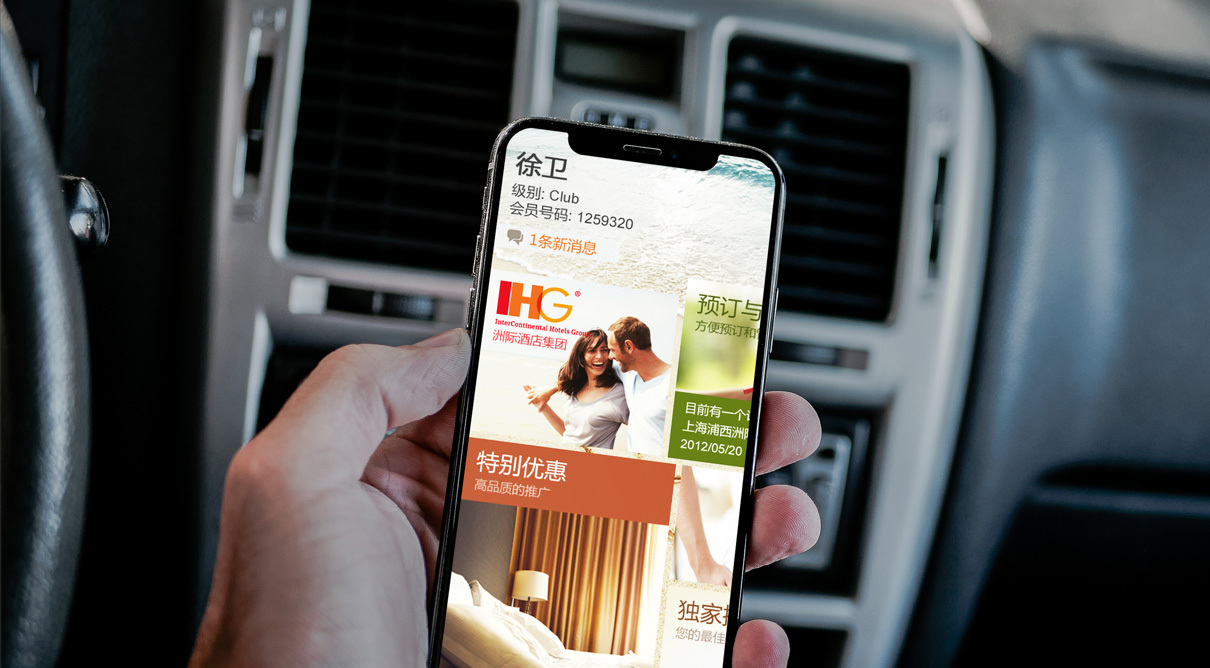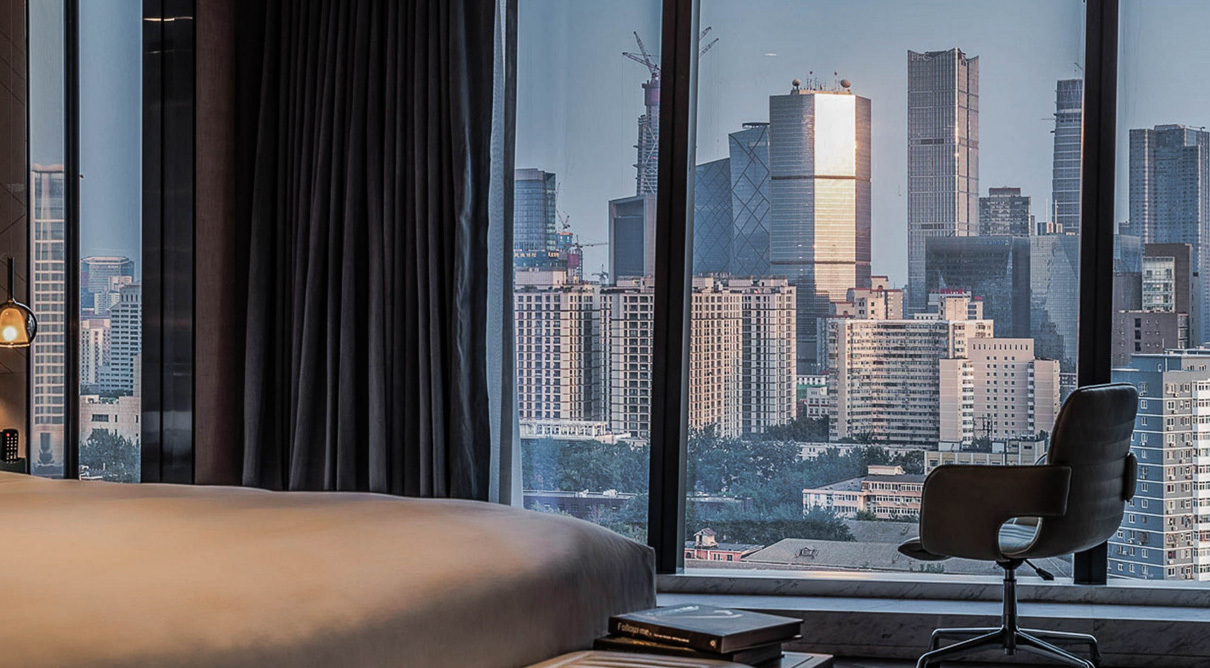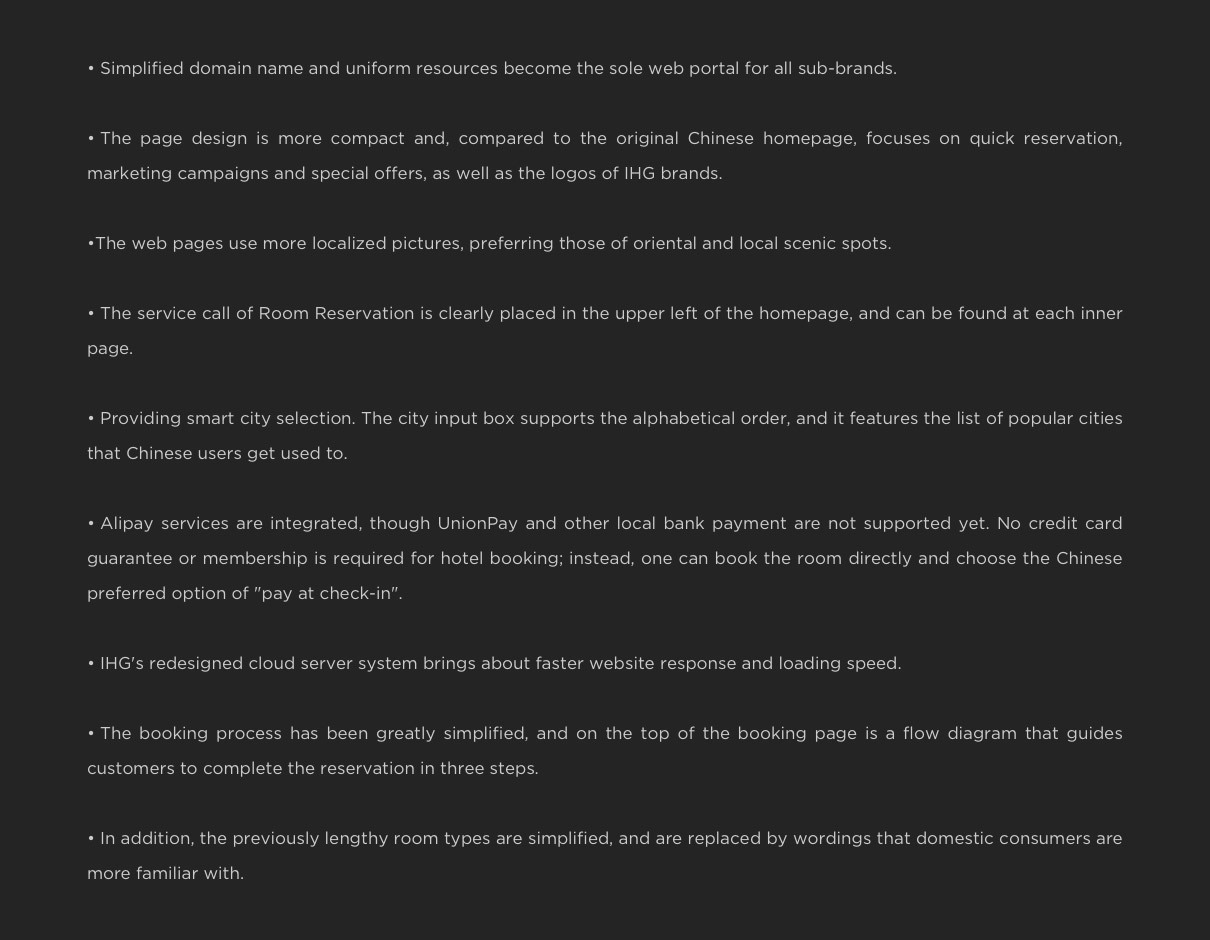Insight | Industry
When the West Meets the East: The Localization Journey of E-commerce for International Hotel Brands


TANG UX
Building Better Brands in the Age of eXperience
Share to
[Travel Daily] (Reporter: Karen Tang)
The City Climate Analysis on Hotel Markets in China jointly released by Jones Lang Lasalle Hotels and China Tourist Hotel Association in 2012 pointed out that there was an international brand hotel opening every four days in China, and China had become one of most competitive hotel markets in the world featuring rapid growth. When hotel groups from the West meet consumers in the East, however, due to differences in language and culture, they often fail to successfully promote the value created by sound products to the Chinese market, and it is often difficult to be favored by Chinese consumers. L2, a well-known digital IQ research company, pointed out in its hotel digital IQ study of 2013 L2 Think Tank, that many international hotels had focused on the rapid expansion of the Chinese market, but they had missed the boat in the competition of the on-line channels; one of the most prominent question was although many international hotels offered the choice of Chinese language in the pages of hotels for the Chinese market, they failed to provide a Chinese version regarding page or booking process of the hotel.
Mr. Zhang, working in a Beijing-based Internet company, is a typical business traveler. He is a member of multiple international hotels and often book rooms through the hotel’s official website due to the photos. “because it does not look like an official website of a hotel, and you will be attracted by photo with a storyline and finished the booking naturally.” However, he believed that there were several problems existing in the Chinese website of many international hotel groups: the information is only about the hotel itself while that about the surroundings of the hotel or target groups is too limited; lacking of interaction, neither social networking sites nor on-line customer service is provided. In addition, the pages often automatically jump to English ones when booking, and design of many websites make users prone to get lost.

In response to the dilemma of Chinese websites faced by international hotel groups in terms of user experience, Jason Huang, CEO of TANG User Experience Design Consulting Co., Ltd. (hereinafter referred to as TANG Consulting), said that this was caused by several factors, but the most fundamental one was that both the planning and design of the Chinese version of many international hotel groups were dominated by foreign design teams in the headquarters located in Europe and the United States, leading to high communication cost, and low communication efficiency is low due to differences in language and time. These teams or consultants at the headquarters usually take the well-known OTA website as their research object the first time in order to understand habits of domestic users and the similar layout designs or practices were usually adopted. Secondly, the international hotel group had high requirements on specifications of the brand visual identity system, and the Chinese websites open to the Chinese market would often translate the copywritings of the English version into Chinese only, while using the same visual and color elements. Therefore, for Chinese users, the expression was often not fluent and awkward when reading, and most features in the pictures or videos were with western faces. However, the most serious problem is the marketing and booking links which are delocalized. All problems mention above made it difficult for Chinese travel consumers to fully integrate into the “story context” when browsing or booking. Therefore, he held the view that the Chinese official websites of most hotel brands was just a translated version of the English one, while the most critical factor “website experience design process oriented by Chinese users” was ignored.” He added: “user differences in different regions are not only limited to language; they differ from each other in terms of content, usage habits, decision making, visual and emotional preferences. Meanwhile, compared with traditional e-commerce websites, the brand story and content quality of travel-related websites play a very important role in terms of user experience.”
In 2011, InterContinental Hotels Group, the world’s largest international hotel management group, began to consider creating a brand portal in response to the needs of Chinese consumers, aiming to enhance its on-line market share in China. James Xu, Product Manager of the Website and Interactive Marketing, InterContinental Group Greater China, said that the goal of the hotel brand is to be “Glocal”. “As time passes, the functions will be further optimized; we hope that the new Chinese website will become a portal for Chinese customers the hotel group. All the services required by customers can be obtained or gain feedback through the website or faciliate the website bookings.” he added.

However, the same as other international hotels, the Intercontinental Group has multiple brands including InterContinental, Indigo, Crowne Plaza, Holiday Inn and Holiday Inn Express. And each brand has its consumer groups with different needs. How to make Chinese consumers complete the on-line searching, browsing, enquiry and reservation of hotels ranging from economic level through mid-class to high-end ones of the Intercontinental Group? This becomes an urgent task for the Group.
Two years ago, TANG Consulting began to help Intercontinental Group plan and design its new Chinese portal and mobile services. For creating an E-Service closer to the needs of Chinese user for international hotel groups, Jason Huang proposed the following five suggestions regarding overall design and implementation for websites.
E-Service Design Development Process Featuring Customer Centric
Jason Huang said that the international hotel group should return to the basic user demand points, conduct detailed user research and evaluation on target customer groups to tap user’s preferences and expectations for hotel brands and products, and understand the roles that the hotel’s current channels play in the travel ecosystem of the traveler, as well as interactions between the channels to create cross-channel service experience both on-line and off-line that is appropriate for the target group. He took the Intercontinental Group as an example. The group has several brands, among which the Intercontinental brand is mainly targeted at high-end consumer groups, who are normally middle and high-level managers of foreign companies located in China and government officials. With good educational background and international perspectives, they show interests in the international style and long history of the brand. Besides, they are skilled at English, and has high requirements on copywriting and visual aesthetics. Therefore, international hotel brands cannot ignore the real demands from consumers during localization. The hotel should make efforts to gain in-depth understanding of the needs of local users through on-site observations, actual interviews and usability testing, as well as analysis on data including bounce rates, and ROI.
International Standard, Localized Thinking
International hotel groups generally have uniform requirements on the content of official websites around the world. Most of the content and pictures are completed by the headquarters and then translated into different languages. However, when facing the Chinese market with different cultural backgrounds, How the international hotel groups can seek a balance between the consistency and localization of the official website? Jason Huang said that instead of being trapped into the misconception of localization, international hotels should have localized thinking and maintain the positioning and standard of international brands at the same time. In particular, he pointed out that in fact, for mid-to-high-end brands of the International Hotel Groups, there is little difference in habits and visual preferences between on-line users from the East and West. The main differences are reflected in the content covered, the booking process and the logic thinking of social media utilization. Moreover, the design details between different levels of hotels of multi-brand hotel groups depend on the goals and positioning of the website and the design of marketing activities. Therefore, in the process of localization, the overall brand vision should be maintained at the international standard in a unified manner. It is not recommended to use Chinese Pinyin as the domain name before being aware of the needs of real target groups, or use too much so-called Chinese colors such as red on the web to draw attention of Chinese consumers.
However, he stressed that for presentation of the content itself, we must give priority to the information that is most concerned and used by Chinese users. For example, high-end users pay more attention to hotel facilities and services, while young people were focused on cost-effectiveness more. At the same time, some necessary elements related to Chinese consumers including renovation time, room size, “free” Wifi or “free” breakfast are often overlooked by Chinese consumers. In addition, the design of input boxes and interaction also call for localization, which means using languages within the cognitive structure of local users as much as possible. He said that “how to seek a balance between internationalization and localization is one of the most important challenges the international hotel is facing.”
Cross-channel Integration & Full Integration with Social Media
Taking Intercontinental Group as an example, what TANG has provided with the Group is Cross channel eService, which means that the Group can achieve integration of digital channels including Web, WAP, APP, WeChat, Weibo, Email, and SMS, as well as user interaction between them. In addition, Jason Huang believed that the Chinese market had its own unique social media ecology, and it is necessary for the international hotel groups to actively use important social media channels such as Weibo and WeChat. He further emphasized that “social media should not only feature the function of sharing on the official website; instead, it should achieve holistic integration with products and services by multiple channels. And before making decisions on how to use social media functions, the hotel should understand how consumers interact with brands through Apps, mobile phones and other social media from a strategic perspective.”
Hotel Brand Story & Visual Preferences of Target Groups
Hotel brand is one of the most important factors in creating user experience of the Chinese official websites of international hotels. Jason Huang said that the international hotel group make the most of its time-tested brand story to attract Chinese consumers through copywriting, pictures or videos in a “story-telling” way. The layout, color scheme, font and size of the website page are to vary due to culture differences of the East and West. The color of the page or the logo brand has different meanings. However, compared with other e-commerce sites selling tangible products, what hotels sell are intangible products, so photos are the factor affecting user perception in a most direct way. The fact that photos convey emotions is an important factor in transforming the user from Looker to Booker. International hotels should make better use of the its geographical advantages; for example, it can highlight the holiday atmosphere by using pictures showing the seaside scenery of the resort to attract tourists for leisure.
One-step Product Booking Process
Jason Huang said that during his cooperation with the hotel, he found that the booking and payment link are often the most important factor that cause many Chinese consumers to abandon using the hotel website. There is no guidance step on the booking page for many international hotel groups; furthermore, because the central booking system is used, the page often jumps to the English one when booking; a large number of customers are lost at the step. Chinese users who are already familiar with the main OTA booking process in China are prone to be lost in the complicated booking process guided by the Western-style thinking. At the same time, international hotels usually only provide the service of payment by credit card, while Chinese consumers prefer to local payment methods such as pay in cash at the front desk, Alipay and UnionPay.
With the extensive increase in domestic consumption, many international hotel groups have accelerated the expansion in China, and local customers have gradually become the main source of customers. Many hotel brands are rushing to launch Chinese-style services. However, when observing international hotel brands, people tend to focus on products and services they provide, marketing techniques and the design style of the hotel itself, while user experience of the Chinese official website is often ignored. How could an international hotel find a suitable consult to work with it to create the Chinese official website? James from Intercontinental Group shared its experience “Hotels need to find partners who understand the Chinese market and the habits of domestic guests, and can provide practical advice and design; experience and ability to cooperate with international groups and companies, as well as a certain understanding on hotel groups on even the hotel industry are also required. Jason Huang said full communication, mutual recognition and respect are needed for cooperation between website design consultants and international hotels, as well as a trial period. However, key factors for success of the website include: whether the international hotel group can give full authorization to the local design team; whether a consistent consensus has been reached from the website executives to even the top management; the recognition of the execution team by senior management, and its decision-making abilities. He emphasized that “consumers will change their needs over time; the website and content are static while the Scenario Context is dynamic and live. For Chinese official website, “can be used” is not equal to “easy to use”, which is not equal to amazing use experience. Localization from internal to the external is needed to give users the best website experience and create maximum value.”

Editor’s Note:
The localization of e-commerce for international hotel groups seems to have taken a small step. However, there is still a long way to go. There are changes in terms of keeping up with changes in the localization needs of Chinese consumers, the integration of internal processes and multi-channels, and more authority from the management. As the experience gain from the new wave of tourism consumption under the context of “contextualization” highlighted by “Cult of Context”, theme of the upcoming PhoCusWright Tourism Annual Summit in November this year: the secret of the success of the e-commerce localization for international hotel groups in the Chinese market lies to meet the individual needs of Chinese travelers. Chinese travelers can no longer be tolerant of mediocre designs or websites or services that emphasize “Chinese culture” more in name than in reality.
Based on the full Chinese context, the brand new Intercontinental hotel portal, after two years of recreating, seems to be more in line with the using habits of domestic users. TANG has summarized 9 highlights as follows:

How can X Thinking help you?
It all starts with a conversation.


